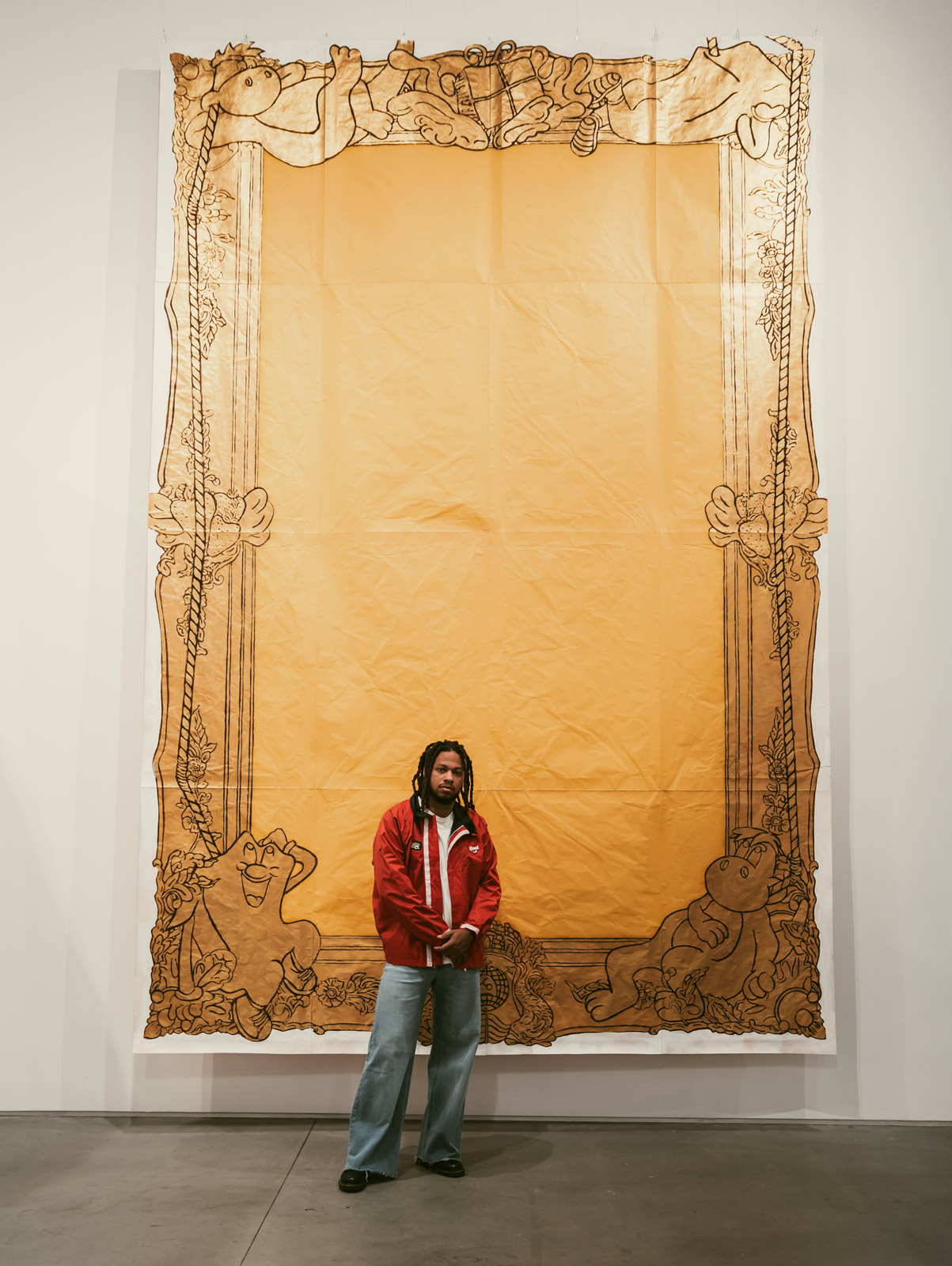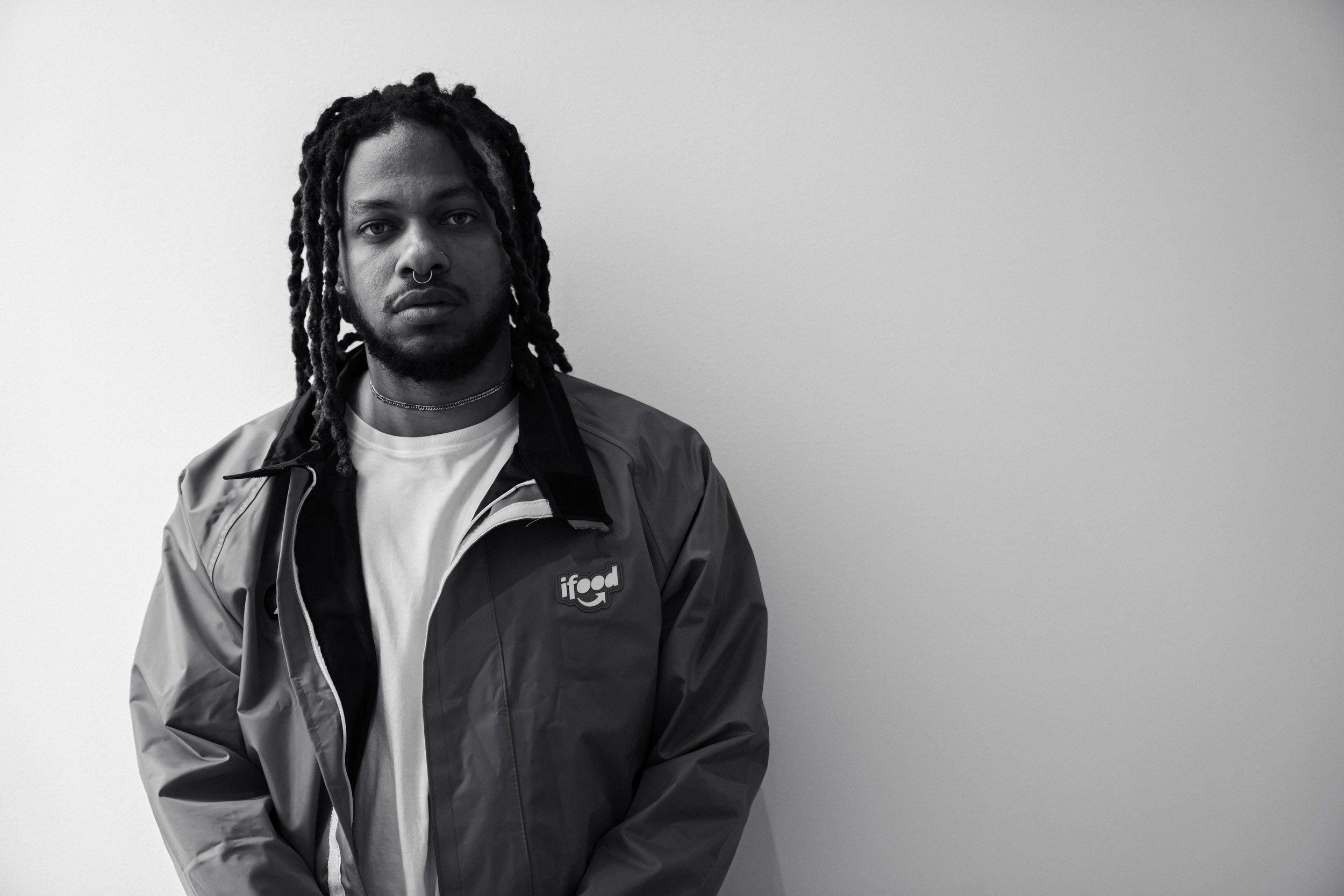In ‘Pardo é Papel,’ the painter presents large-scale figurative paintings driven by anthropological note-taking and his roots in Rocinha
Maxwell Alexandre grew up in the Rocinha favela of Rio de Janeiro, where he still resides. In his first American solo exhibition, Pardo é Papel: The Glorious Victory and New Power, the artist built an extension of his home city at The Shed in New York’s Hudson Yards. Rather than affixing his paintings to the gallery’s walls, Alexandre suspended them in the air with fishing wire and black binder clips. The 10.5-foot-high, paper-bordered corridors create a labyrinth that viewers must navigate as they come face-to-face with his lifesize portraits. Alexandre designed a sacred architectural palace, where his divinities hang overhead: boldly drawn, large-scale Black figures, usually garbed in urban streetwear and donning bleached blond hair.
These paintings double as sculptures, maximizing the effect of their chosen canvas: pardo paper. Alexandre’s practice is a byproduct of the socioeconomic climate of his adolescence; lacking access to traditional methods of painting—like oils or upscale pigments—he searched his home for alternative materials: hair dye, shoe polish, latex paint, and other seemingly-random commodities. Alexandre chose pardo for the access it offered, later coming to realize its conceptual significance: In Portuguese, pardo refers to an ambiguous racial category that was historically used to trivialize Black identity in Brazil—“for whitening in Brazil,” the artist clarifies. For Alexandre, pardo paper bears a unique temporal condition. “Unlike canvas, paper [is unforgiving]. You have to think and act quickly,” he says.
Alexandre finds power in the denial of his painterly status, referring to himself as a “stenographer” who treats painting like note-taking. Perhaps what he alludes to with the title New Power is the sure deterioration of his work over time. His paintings’ impermanence resists the framework of the museum, pushing back on the acquisition of Black communal artwork to demonstrate, in turn, Glorious Victory.
Yuki Xu: Your paintings float above the gallery floor, suspended by fishing wire and black binder clips. Is that a conceptual extension of the work, or simply an aesthetic choice?
Maxwell Alexandre: I think that it transits between those two elements. These decisions are very precise, and there is careful consideration and alchemy in my [choice of materials]. I wanted the large banners of pardo paper to be presented as more than painting.
This series bears important qualities of sculpture, such as in the way that I manipulate the public’s path within galleries and museums. These works aren’t framed or hung on the wall, but rather float—they’re hung by braided steel wires descending from the ceiling, [creating] a sublime and religious impact.
Yuki: What effects are intended by the monumental scale of your work?
Maxwell: The scale is not arbitrary. It has to do with the desire to call attention to the two main motifs of the series, which are the pardo paper and the Black characters. I needed to create density, and I wanted to reach maximum contrast between these two bits of information. It is important to observe how this exhibition was conceived, since it affirms—among other things—the place of an artist who is plural.
Pardo é Papel transcends painting: It goes beyond the bidimensional. It’s also about sound, air, and space. Suspending the paintings not only proposes an architectural mediation—dividing the exhibition space into smaller sub-rooms—it also allows the public to see the backs of the works. They come into contact with crinkles and tears, which brings attention to [the works’] fragile materiality.
Yuki: Can you speak to how your upbringing in Rocinha influenced your material choices, and your understanding of space, texture, and color?
Maxwell: When you look at my work today—and observe both the physical support and the constructive, pictorial materials—you might assume that it has all been thought out in great detail. The bricks, the hair dye, the shoe polish, the latex paint—in all of these elements, there is a strong coherence [between the materials and] the subject matter that I am revealing. But these decisions were made out of necessity. I did not have money to make paintings with oil on canvas. I was thinking about what was financially accessible, but had pictorial potential. That is how I started using henna dye; it is very much part of the [culture I grew up in]. I remembered the smell of it, which sent me back to childhood. The shoe polish I use for painting today is the same I used on my boots when I was serving in the army. The wall paint that I like so much—for its porosity and matte appearance—used to cost just 20 Brazilian reals for a large bucket. I would have enough paint for the whole year.
Yuki: Pardo refers to an ambiguous racial category that has historically been used to trivialize Black identity in Brazil. As you developed this body of work, how did this material inform your practice?
Maxwell: Pardo paper has specific conditions. It bears memory. Unlike canvas, paper [is unforgiving]. The material gets wet and heavy with the application of paint. You have to think and act quickly, otherwise the work gets torn [and destroys] itself; it breaks apart right in front of you. In this sense, I think that pardo paper puts you into a state like that of a stenographer—treating painting like note-taking.
The time I spent producing in the fashion lab at college put me into constant contact with pardo paper. I began to collect the scraps that students left behind. I was interested not [just] in the material, but also in the notes, drawings, and measurements students marked when making patterns for the clothes they were designing. In fashion and art workshops, paper and fabric convey similar values: The former is the sketch; the latter is the thing itself. Both the garment and the canvas indicate the final product. It’s interwoven, to last a lifetime. The paper has a fragile life. It cannot be preserved. This material denies me the status of a painter. I do not come from an art school—a school of painting. My work is note-taking. My paintings are notes, jotted down in a sort of shorthand.
Yuki: I’m curious about how you select and expand upon symbols in your work, such as the wave pattern derived from Capri pools, or the Toddynho logo.
Maxwell: I consider big brands to be powerful entities—so powerful that they become invisible. They force our habits and dictate our behavior. Brands like Danone and Toddynho frustrated me in my childhood, because I could not consume them. But today, as an artist, where everything is possible, I can manipulate these entities and their narratives to satisfy my desire—or create ambiguities in a new mythology of my own.
Yuki: Can you speak to the scenes of victory and prosperity you depict in your work? What’s the significance behind this exhibition’s subtitle, The Glorious Victory and New Power?
Maxwell: Vitória Gloriosa is how I titled the period of production of the first Pardo é Papel works. These paintings configure narratives of upward mobility for the Black community—a mainly material ascension. There is always the representation of an imagery and mindset that hovers around the acquisition of precious jewelry, expensive telephones, new cars, private jets, and yachts.
Vitória Gloriosa also refers to professions that are commonly used as a platform for upward social mobility for Black people in Brazil: the fields of sports and music. I also bring contemporary art as a prophecy of a Novo Poder—a new power—for the Black community. Thus, Novo Poder mirrors Vitória Gloriosa, and Vitória Gloriosa mirrors Novo Poder.













